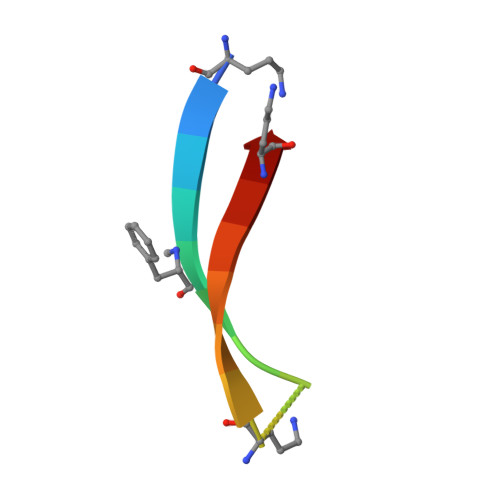Repurposing Triphenylmethane Dyes to Bind to Trimers Derived from A beta.
Salveson, P.J., Haerianardakani, S., Thuy-Boun, A., Yoo, S., Kreutzer, A.G., Demeler, B., Nowick, J.S.(2018) J Am Chem Soc 140: 11745-11754
- PubMed: 30125493
- DOI: https://doi.org/10.1021/jacs.8b06568
- Primary Citation of Related Structures:
6DR4, 6DR5, 6DR6 - PubMed Abstract:
Soluble oligomers of the β-amyloid peptide, Aβ, are associated with the progression of Alzheimer's disease. Although many small molecules bind to these assemblies, the details of how these molecules interact with Aβ oligomers remain unknown. This paper reports that crystal violet, and other C3 symmetric triphenylmethane dyes, bind to C3 symmetric trimers derived from Aβ 17-36 . Binding changes the color of the dyes from purple to blue, and causes them to fluoresce red when irradiated with green light. Job plot and analytical ultracentrifugation experiments reveal that two trimers complex with one dye molecule. Studies with several triphenylmethane dyes reveal that three N, N-dialkylamino substituents are required for complexation. Several mutant trimers, in which Phe 19 , Phe 20 , and Ile 31 were mutated to cyclohexylalanine, valine, and cyclohexylglycine, were prepared to probe the triphenylmethane dye binding site. Size exclusion chromatography, SDS-PAGE, and X-ray crystallographic studies demonstrate that these mutations do not impact the structure or assembly of the triangular trimer. Fluorescence spectroscopy and analytical ultracentrifugation experiments reveal that the dye packs against an aromatic surface formed by the Phe 20 side chains and is clasped by the Ile 31 side chains. Docking and molecular modeling provide a working model of the complex in which the triphenylmethane dye is sandwiched between two triangular trimers. Collectively, these findings demonstrate that the X-ray crystallographic structures of triangular trimers derived from Aβ can be used to guide the discovery of ligands that bind to soluble oligomers derived from Aβ.
- Department of Chemistry , University of California Irvine , Irvine , California 92697-2025 , United States.
Organizational Affiliation:



















